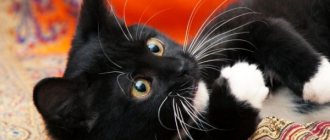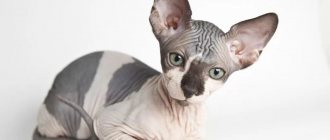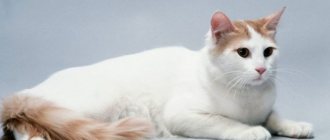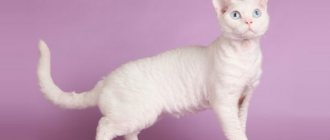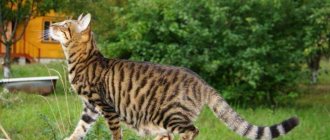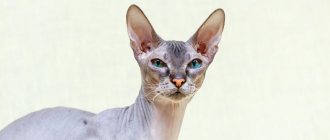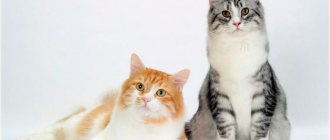Japan is a country where there are a sufficient number of felinological clubs and cat lovers clubs. However, at the moment, only one breed of Japanese breeders has been officially accepted by international organizations of felinologists.
In this country, with its unique traditions and culture, the national flavor leaves its mark on all areas of life, including the species diversity of cat breeds bred here. The unique approach and original requirements for the exterior have led to the fact that the selection of cats here is narrowly focused.
Reasons for the uniformity of selection
In Japan, representatives of the cat world enjoy such respect, honor and exclusive rights that they cannot count on in any other country in the world. This special attitude towards cats is caused by culture and religious and ritual traditions passed down over many centuries.
According to local beliefs, the tail of any animal is a concentration of devilish energy, negativity and destruction. This was the reason that cats with long tails were not particularly popular, while representatives with short tails became inhabitants of the imperial palace. The rest of the cats were destined for a terrible fate: their furry source of pride was simply chopped off by people who wanted to limit themselves from negativity.
It was here that kittens without this organ began to be born. It is possible that such mutations in cats occurred everywhere, but only Japanese residents reacted with enthusiasm to this fact and began to take especially careful care of tailless animals, which was the beginning of narrowly targeted selection.
The trait quickly took hold and became the main anatomical feature cultivated in Japan. Since the country remained closed for a long time, the new standards did not make any changes, and the breed became increasingly established and rooted during crossings between similar specimens. The species is called the Japanese Bobtail.
Japanese exterior
Japanese cats have clear exterior requirements that they must meet:
- They are characterized by the genotype of the Japanese Bobtail and are directly related to it.
- Good health is a must.
- By color, the most common are bicolors with a predominance of white, calico and tortoiseshell-white. Only colorpoints and the Abyssinian phenotype are excluded.
- The key feature is taillessness.
It is important to know that the presence of heterochromia (different eye colors) in cats is a consequence of American selection, therefore such a representative cannot be classified as a Japanese breed.
The breed received its first recognition in 1976, when the Japanese Bobtail was officially listed by the CFA.
20 years later, another variety was recognized, the result of the work of Japanese breeders - the longhaired bobtail.
Cat breeds with big eyes
Big-eyed cats are different. The gaze of some can be called purposeful and cunning, while others can only express adoration for a person or a plea for a tidbit with their eyes. Dilated pupils, like saucer eyes, add special significance to a cat’s gaze. Peering into their depths, people rarely realize what kind of eyes their pet has: round, almond-shaped or slanted. The first two types can confidently be called large.
Big-eyed cats are among the most beloved
The owners of large eyes can be different cats: long-haired or short-haired, small or medium-sized, with or without a tail. The most popular breeds of big-eyed cats:
- Persian;
- British;
- Scottish lop-eared;
- Abyssinian;
- Japanese Bobtail;
- Singapore;
- Ukrainian Levkoy;
- ragdoll
Persian
The Persian cat is distinguished by its long, thick hair and flattened face. She has a proportional body and a long flexible tail. The Persian's nose is small and snub-nosed, this makes the eyes especially large and round. Together with small ears, the Persian's muzzle takes on a childish and funny look. The appearance of these animals is difficult to forget; they are easily recognizable. Snub-nosed, big-eyed cats can be any color.
Photo gallery: Persian cats of different colors
The smallest Persians have almost no ears visible
White Persian kittens look especially cute
Persians can have spots or stripes (tabby) in color.
The eyes of a Persian cat can be any color, but they must be in harmony with the coat color
The character of Persian cats is phlegmatic. Such a pet will fit perfectly into the interior, but it does not accept training. His favorite pastime is lying on the sofa. But such visible and meaningful laziness does not mean emptiness of the soul. The Persian will love his owner and the rest of the family. Such cats react to affection with loud purring, they can snore at night, and dogs are often simply ignored.
My neighbor once had an orange Persian cat named Peach. He was fat and clumsy, but incredibly sweet. Every time he “floated” past me with a proud gait, I wanted to take him in my arms and cuddle him, but he did not go to strangers. He had big eyes, but I don’t remember their color, because it was Peach’s fur that attracted all my attention.
British
British cats are large animals with a round head and short, plush fur. These cats do not have guard hairs, so their coat is very soft to the touch. British eyes are round and most often bright red, although there are other colors (blue or green). The color of British cats can be almost any color (gray, blue, tabby, white).
Photo gallery: British cats with different coat colors
White fur and blue eyes are a rare combination for a Briton, but there are exceptions
Regardless of coat color, British eyes are most often red (amber, copper)
Britons can have any shade of gray coat
Stripes are allowed in the British coat color
The British cat is a real Englishman, reserved and calm, pedantic and a little prim. The British are so confident in themselves that, without scandals or fights, they feel their superiority in the house, the owner will definitely feel it. This big-eyed handsome guy is completely self-sufficient, he doesn’t need your affection, and other pets won’t even dare to approach him. But he will not offend children, because this is not like a gentleman. Just accept him for who he is.
Scottish lop-eared
The Scottish Fold (Scottish Fold) is an animal with a stocky build and floppy ears that completely cover the pinna. Folds seem heavy due to their round head and short legs, and their tail is of medium size. However, the Scots cannot be called heavyweights. A cat can only grow up to 6–7 kg, and a cat can only grow up to 4–4.5 kg. With their large eyes, small nose and wide-set floppy ears, these cats look naive (like toys), but that's what people like about them. The fold can be any color (there are more than 60 types).
Photo gallery: Scottish Folds with coats of different colors
Scottish fold can be monochromatic, bicolor or tricolor
The eye color of a Scottish cat is in harmony with the coat color
The rarest color of fold cats is silver-lilac.
The most popular fold color is gray
The Scots are calmness itself. Such a cat can be confidently called the most balanced. He is not lazy, but extremely peaceful, so he gets along well with all family members. The fold-eared, big-eyed cat will make friends with any other pets, because he is smart and understands that they are also part of the family. But this cat doesn’t really like strangers. He, of course, will not rush at the guests, but he will not caress them either.
Abyssinian
Abyssinian cats are a combination of sincere feline tenderness and wild African color. The body of the Abyssinian is always slender and graceful, the limbs and tail are long, so the movements of the animal are graceful and aristocratic.
There are four types of color in Abyssinians:
- faun;
- sorrel (copper);
- blue;
- ginger.
Abyssinian cats are often recognized by their red ticked fur (the ends of the hair are darker than the base color). Their eyes are most often red or copper.
The Abyssinian coat appears sandy due to the ripple effect created by the ticked hairs.
The Abyssinian is a sociable and mischievous cat that quickly finds a common language with any person. Such pets love to play and explore their environment; they can choose a child or an adult, another cat or even a dog as a partner. But despite such a restless character, Abyssinians are considered affectionate and friendly, and they have practically no behavioral problems. They can be trained and immediately remember where their litter box is and where their bed is.
Japanese Bobtail
The Japanese Bobtail is a favorite cat of the Japanese, who are crazy about its large, contrasting eyes. Bobtails have a small body with a short pom-pom tail and a head proportional to the torso. The ears are triangular and almost vertical, and the muzzle is wedge-shaped. Big-eyed Japanese are most often white, but may have red or black spots (sometimes bicolor markings) on the head, back and tail. The eyes of these cats can be any color.
The calling card of the Japanese Bobtail is its short pompom-shaped tail.
Japanese Bobtails are sociable animals that are ready to spend their whole day next to a person. Such cats love and value their family very much, they will be active in everything that happens at home. But when it comes to mice, the Japanese are real samurai. The bobtail will give all its energy to catch its prey. The big-eyed Japanese combines devotion to man and hunting instincts.
Singapura cat
The Singapura is a rare breed of Asian cat with a small body and an unusually colored muzzle. The physique of such cats is average, the limbs are proportional to the body, the tail is long and whip-shaped. The head is small, with a wedge-shaped muzzle and large triangular ears. A distinctive feature of such cats is the color of their face (can be compared to a monkey or a small koala). A contrasting dark line rises from the nose to the forehead; there is a “mask” on the eyes, but the large eyes themselves have a light outline. There are two known colors of this cat: sable and ivory. Singapura's large eyes can be amber or green.
The Singaporean cat is considered one of the smallest breeds. Despite their modest size (the largest cat weighs up to 3 kg), Singapuras are very strong. This cat's limbs are muscular, and its paws are oval and wide.
The ticking effect is visible on the Singapura's coat, so the color of the animal can be called wild
The Singaporean big-eyed cat behaves like a lioness. She is graceful and confident, but does not tolerate noise. Such a cat will not be able to live where there are fights and scandals. Singapura is very careful and will first try to study him before communicating with a person. But this feature has become the main advantage of a peaceful and strict cat. In the presence of Singaporean guests, he will not allow himself to become familiar or crazy antics.
Ukrainian Levkoy
The Ukrainian Levkoy is an artificially bred breed of hairless cat with large eyes and floppy ears. The body of the left-handed dog is slender and graceful, the paws and tail are long. The flat shape of the head of the Levkoy is similar to the sphinx, the muzzle is the same with cheekbones, and the mustache is curled. The breed was named after a flower whose petals are curled up like the soft ears of a cat. On its thin face, the big eyes of this cat seem sad and bottomless. The body of the Levkoy can be covered with plush fluff of any color.
Photo gallery: Ukrainian Levkoi of several colors
Levkoy's eyes can be any color (from blue to dark brown)
The color of the gillyflower can be solid or spotted
The rarest color of the gillyflower is color point.
Ukrainian Levkoys are distinguished by their devotion to their owners; they quickly get used to the family and are ready to be petted all day long. But such cats cannot be called intrusive or annoyingly sad. They are quite playful and moderately cheerful. Levkoy is intelligent and trainable. The owner will not have to complain about him, and the pet will not be offended by the person, because he is absolutely not vindictive.
Ragdoll
Ragdolls are large American cats with semi-long hair. An adult big-eyed ragdoll can reach a meter in length and weigh up to 10 kg (cats are slightly smaller). The breed got its name because of a rare gene that allows a cat to relax in the hands of a person to such a level that it becomes like a rag doll.
The fluffy cat's body is muscular, its chest is wide, and its legs are short. Ragdolls have soft (rabbit-like) and silky fur. The head is wedge-shaped, the ears are round and medium in size.
The peculiarity of these cats is the combination of blue (less common yellow and green) eyes with one of three types of color: color point, bicolor and mitted.
Photo gallery: three types of ragdoll colors
The bicolor color can be recognized by the white marking on the face in the form of an inverted letter V
With the color point color, there are markings on the face, ears, tail and paws, and the markings can be any color (from blue to chocolate)
The mitted color is similar to the color point, but the cat has noticeable white “socks” on its paws.
Ragdolls are real dolls; they can play with children for a long time or communicate with a person. Such cats quickly and permanently become attached to their owners. They are affectionate and playful, completely unable to attack or defend themselves. Sometimes their gentleness and dependability puts lives at risk. Such a cat could be stolen, but he wouldn’t make a sound. He may fall out of the window, but he will not frantically seek salvation on the street. Such cats need to be adored, caressed and constantly monitored.
Shorthair Japanese Bobtail
The gene that is responsible for the main characteristics of this cat breed is in a recessive state, which means it cannot manifest itself when crossed with other breeds. Therefore, when buying such a kitten, you need to pay special attention to its pedigree.
Appearance
The body size of the Japanese Bobtail is average, the proportions are harmonious. Has a characteristic “samurai stance”, which is one of its notable features.
The cat's head is in the shape of an equilateral triangle and has an elegant muzzle. The ears are vertical and high set. The large oval eyes have an attentive expression; ideally, their color should be in harmony with the color of the coat.
The color is not variegated and is usually limited to two colors. The coat is single-layered, since there is no undercoat due to the fact that the origin of the species began in a mild climate. The cat does not shed intensely, so it does not cause severe allergies. The taillessness of the breed is somewhat exaggerated: in fact, the cat has a tail rudiment measuring from 2.5 to 7.5 cm. Thicker and longer hair grows on it, which forms something like a pompom.
Character
They have an easy-going character and a reputation for being affectionate cats. They are very active and love movement, but most of all they prefer those games that can be played with the owner.
The coat has good water resistance, so many cats of this breed love to swim in the bathtub or open water. Another feature is a wide range of sounds: these cats can reproduce various sounds from meowing to something similar to bird trills.
They need frequent attention from the owner, since such a cat, left alone for a long time, can show its protest in the form of dirty tricks: torn wallpaper, scratched furniture or overturned flower pots.
Health
Long centuries of street life, during which these cats were forced to catch mice and obtain food on their own, have led to the fact that Japanese Bobtails have excellent health and strong immunity. They rarely get sick from most feline diseases and recover quickly.
Kittens of this breed begin to walk and become independent much earlier than other felines, and their life expectancy is about 15 years.
Features of caring for cats with large eyes
Whatever breed your big-eyed pet is, you need to take care in advance about the conditions in which it will end up. To make your cat comfortable in your home, you will need the following things:
- a bed, a house or a play complex (you need to select it according to the size of an adult cat of the selected breed);
- scratching post and nail clipper (the scratching post can come complete with the house, or be separate, in the form of a small toy);
- ceramic or metal bowls (2 pieces for food, 1 for water);
- first aid kit (iodine, brilliant green, tourniquet, bandage, cotton wool, business card of the nearest veterinary clinic, etc.);
- clothes for the cat (if the pet is hairless);
- combs (combs, brushes, slickers, furminators - depending on the length of the coat);
- shampoos and conditioners for bathing (cats need to be bathed approximately once every six months or more often if they are dirty);
- cotton swabs for cleaning ears (the procedure is carried out 1-2 times a week, for fold-eared cats - every day);
- cotton pads for wiping eyes (every day);
- harness and leash for walking (it is convenient to choose harnesses with an adjustable size);
- carrying bag for trips and trips.
Features of fur coat care for each individual cat are determined by the nuances of the breed, the length of the coat and the character of the pet. For example, hairless cats are not combed, but wiped with a damp cloth. This procedure can be carried out every day. Hairless cats (like the Ukrainian Levkoy) sweat more than their furry counterparts, causing sweat and dirt to accumulate on the animal's skin. It is important to dress the cat in warm cat clothes immediately after the procedure (hairless cats can catch a cold).
Short-haired cats are brushed once a week (with a comb or brush). You can bathe them once every six months. But long-haired pets require more complex procedures. The longer the coat and the thicker the undercoat, the more time you will have to spend on combing. This must be done daily, otherwise tangles may form (and unraveling them is painful). But you can bathe fluffy, big-eyed cats up to 4-5 times a year.
A long-haired cat may not like the slicker, because sometimes the curved teeth of the slicker can pull out healthy hair. Of course, there are cats that love to be brushed, for example, my grandmother's former cat loved her slicker, waiting for the procedure to be repeated every evening. I heard that it depends on the nature of the animal. For example, Persian cats are lazy, so they don’t care what their owner does to them.
Video: how to comb a cat
Eye care
Every owner of a big-eyed cat should know how their pet's eyes work: there is a small amount of liquid between the eyeball and the mucous membrane. It is needed to make it easier for the eyelid to glide. In addition, the fluid is constantly renewed, and the old one comes out in the form of mucus along with dirt that gets on the membrane of the eye. The inner corner of the cat's eye is directed downwards, and is continued by an almost imperceptible path (a line that can stretch along the length of the nose). Excess liquid should flow out along this path. In the morning, discharge may accumulate in the corner of the eye, forming a crust.
Often cats can remove this dirt themselves when washing themselves, but humans must monitor the cleanliness of their eyes. Some snub-nosed cats (for example, Persians) have a special structure of the nasal septum. Because of this, discharge from the eyes may be profuse. You shouldn’t be afraid of this; this feature is considered the norm for such breeds.
To avoid any problems with your pet’s eyes, you need to examine the animal every morning. You need to wash and remove dirt not only from the very corner of the eye, but also from the fur around it. A small part of the discharge with dirt may remain here; if it gets back into the eye, inflammation may begin. To wipe a cat's eyes, you need cotton pads and distilled water.
Pet pharmacies sell a special gel or lotion that is convenient for treating the eyes of adult cats.
Some owners of mustachioed pets use tea to moisten cotton wool. A strong infusion of tea is very beneficial for the eyes, but the dark liquid can stain the fur of a light-colored animal. This is important to consider if your pet is going to have any kind of show (for example, an exhibition).
To wipe the eyes of light-colored cats, you need to use a clear liquid.
You can determine if your pet has problems with his eyes using the following criteria:
- discharge;
- lacrimation;
- red or white inner eyelid;
- hard crusts (scabs) in the corners of the eyes;
- fur on the face with traces of tears;
- closed eye (or both);
- clouding of the eye or change in its color;
- visible third eyelid;
- changes in behavior.
Gestures and facial expressions of cats can also warn of a possible illness. If a cat's eyes hurt, it may squint or scratch its face with its paws. If you notice any of the above symptoms, you should contact your veterinarian. Some cat owners try to cure their pets themselves using medications intended for humans, but this is strictly forbidden. Only a veterinarian can determine the disease and prescribe the correct treatment.
When my friends' cat got sick, they made a mistake - they started self-medicating. The cat's eyes were watering, and the owners tried to treat her with antibiotics and some other pills, having read about a rare disease that people usually bring from resorts. Treatment didn't help and they had to see a veterinarian. It turned out that the cat had conjunctivitis. The veterinarian prescribed an ointment, and the animal was cured. But in total, the cat suffered for almost 2 months. If the owners had immediately gone to the veterinary clinic, this torment could have been stopped much earlier.
If a cat has eye problems, you should not self-medicate.
There are many diseases related to the eyes. The most common ailments are:
- Conjunctivitis: Your cat's eyes appear red and swollen, and there may be some discharge. Caused by injuries, foreign bodies, chemicals entering the eye, as well as infectious diseases.
- Protrusion of the third eyelid: If the third eyelid becomes visible and covers your pet's eye, he may be injured, suffering from diarrhea, viruses or worms.
- Keratitis (inflammation of the cornea of the eye): if the cornea of the eye is inflamed, it becomes cloudy and watery.
- A cataract is a clouding of the lens, causing it to become smoky or white. This is often seen in older cats, as well as those with diabetes.
- Glaucoma: The cornea becomes cloudy and the eye becomes enlarged due to increased pressure in the eyeball. If you do not immediately contact a veterinary clinic to reduce intraocular pressure, the cat will go blind.
- Bulging eye(s): Bulging of the eye can occur due to injury or swelling.
- Retinal diseases: associated with the degeneration (degeneration) of light-sensitive cells in the back of the eye, can lead to partial or complete loss of vision.
- Tearing: Hair around a cat's eyes that shows signs of tears indicates a blocked tear duct or overproduction of tears.
The veterinarian makes a diagnosis and prescribes treatment. Doctors usually prescribe medications that are sold in pet pharmacies:
- Lacrimin;
- Lacrican;
- Levomycetin (0.25%);
- Hydrocortisone or tetracycline eye ointment;
- Iris;
- Tsiprovet;
- Anandin.
The best prevention of cat eye diseases is regular preventative examinations with a veterinarian, timely vaccinations and proper care.
Feeding cats with big eyes
Breeders recognize three types of feeding: ready-made food, natural food and mixed food. With any option, it is important to consider that the diet must be balanced . Industrial feeds are already formulated in such a way that they contain proteins, fats, carbohydrates and vitamins in the correct proportions. But with natural feeding, responsibility for the balance of microelements rests only with the owner. The cat should receive various vitamins necessary for proper bone growth, healthy fur, good vision, etc.
Sometimes you can read a request for a treat in a cat’s big eyes, but you shouldn’t give in - the cat must have a complete diet rich in vitamins and no harmful substances
Owners who believe that their cat needs vitamins buy or plant special grass. Animals enjoy eating green sprouts. This grass is safe, you can’t overeat it, and cats don’t get better from it. But it contains a lot of vitamins and fiber, which, among other things, has a beneficial effect on the pet’s gastrointestinal tract.
Cats need almost all the same vitamins as humans. Breeders attach particular importance to the following:
- Vitamin B2. Due to the lack of this vitamin, weight loss occurs, baldness occurs on the spine, near the eyes and around the ears. The owner will notice cloudy eyes and weakness of the animal. Kittens experience slower growth.
- Vitamin B12 improves liver function and nervous system. Without it, the cat is inactive, rarely goes to the toilet due to constipation, although she drinks a lot of liquids. The vitamin is found in cottage cheese, fish, beef, and poultry.
- Vitamin C is necessary to strengthen cells, increase resistance to infections, absorb calcium and iron, and cleanse the blood of toxic substances.
- Taurine. This substance improves vision, but it is important to consult a doctor to determine how much your cat needs.
To determine which vitamin cats are lacking, you need to undergo a series of tests. This is why it is so important to visit a veterinarian.
Longhaired Japanese Bobtail
This breed of cat also had other names: “Bobby” and “Chrysanthemum cat”, but it was officially recognized as the Japanese Longhaired Bobtail.
Appearance
Average body size, weight does not exceed 4 kg in large males. The body is muscular (not skinny). Due to the fact that the hind legs are longer than the short ones, this species has a specific uneven gait, with peculiar “jumps” of the rear part.
Unlike the short-haired modification, the long-haired ones do not have a flattened muzzle, but they do have a small depression at the transition from the forehead to the nose. The ears are set wide apart and may appear to tilt slightly forward when the cat is at rest.
The coat has an undercoat, but pronounced shedding occurs only in the spring and takes no more than 5-6 days. There may be a small “collar” of wool around the neck.
Character
The cat is very active and active, but unlike the short-haired cat, it is more jealous, so keeping it in a family that already has a dog or other pets is not worth it, as this can cause a sharp deterioration in its character. If she gets enough attention, she becomes a very gentle animal that adores her owners.
Health
Since this variety is a derivative of the original species, it is less resistant to various kinds of diseases. These cats must be fed with high quality ingredients. If you follow this rule, there will be no health problems.
Cats of these breeds are currently widespread only in Japan, and in the USA and Europe they remain quite rare and expensive, but their exotic appearance and wonderful character make them increasingly popular.
Video
about the breed:
